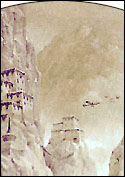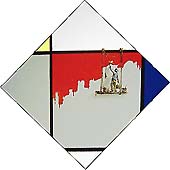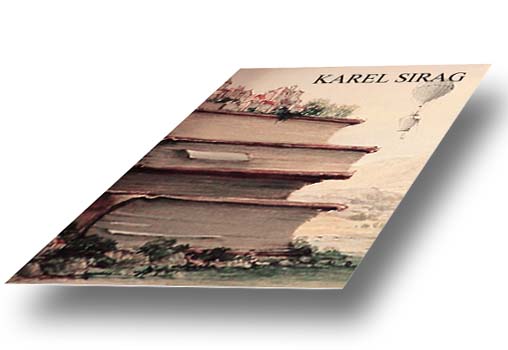((This catalogue has been published at the occasion of Karel Sirag's solo
exhibition, March 4 - April 1, 2000, and is written and compiled by Koen
Nieuwendijk)
The Sirag Calendar
It's true that Karel Sirag's latest miniatures are dated 2000, but that is
something the world he depicts is blissfully unaware of - which is not to
say that his world is frozen in time. Things have been invented for
practical reasons, even if it seems as if the population fails to appreciate
the true meaning of many an act, as if they have forgotten how it could
possibly have come to this. With due respect I would refer to the mysterious
strips of land in South America that resemble runways, imagining a group of
abandoned space travellers who after a couple of centuries had somehow lost
track of what these structures had been all about but who nevertheless, by
way of a ritual, poured their heart and soul into works destined never to
serve any useful purpose ever again. Sirag's world population seems to be
condemned to a similar fate - except that we, the spectators, are very much
aware of where it all began. Even so, would we really want to be aware of
our perspective in a situation where a lonely soft drink can - monument to
our consumer society - turns out to operate as a huge water well?
|


|
McGregor Tries Again
The past has taught us in no uncertain terms that everything we once
opposed, everything we once regarded as disgraceful or unfeasible, ceases to
raise even a single eyebrow once a couple of decades have gone by. This is
to Sirag's advantage. His holding a mirror up to our faces in his depiction
of the trials and tribulations of McGregor, his personal pastiche of Icarus
(incidentally, I have always insisted that Sirag is not a moralist. True, he
will use mankind's carryings-on for his own amusement, but that's definitely
not the same thing), inevitably prompts a choice to be made: either lift-off
is achieved and we'll soon become jaded, or it isn't and we'll happily
settle for a spot of cynical I-told-you-so-ing. With all due respect, I
would however remind you of the proper sequence of events: it is not until
we have mastered the art of stomaching both alternatives by way of human
perspective that we are ready for Karel Sirag's work.
|


|
Genetic Engineering
Any attempt to classify Sirag's work is provisional. I don't mean to depress
you with this hypothesis - please bear in mind that virtually every
scientific insight that was proudly won at one time or another has since
been superseded by another, so what is actually true of what we think we
know? And before you get the wrong idea, let me assure you that Karel Sirag
is definitely not a pessimist, nor am I. In fact, both he and I are avid
readers of the scientific section of NRC Handelsblad, the Netherlands' most
respectable broadsheet, which after all owes its existence to the very fact
that things will invariably turn out to be different than we originally
thought. Take genetic modification, for example. Mankind has learned to be
wary of anything we are told will make our lives infinitely better, and we
know right now that some things will inevitably turn out wrong with GM
(although I hasten to add that other things will inevitably turn out right).
Be this as it may, the people inhabiting Sirag's miniatures have had to deal
with the gigantic dimensions of strawberries, cherries, onions and apples
for many decades, and yet they don't give the impression of putting up any
sort of fight. Of course there are harvesting and transport issues to be
thrashed out, and we don't get to see exactly how they deal with selling and
consuming the stuff, but they don't give the impression of letting any of
this faze them. If there is a lesson to be learned from this, it's that
although we have spent the last hundred years in the unshakeable belief that
we are oh so knowledgeable, with the drive for bigger and better powered by
a different mechanism altogether, how come the strawberry is of such utterly
consumable dimensions, such a perfect fit for the human mouth? Isn't it
because all those edibles snugly fitted into paper bags, boxes and puns long
before genetic modification was even invented?
|
klein.jpg)

|
Hole in One
And so Sirag, scouring the social landscape, hones in many a human
idiosyncrasy. No-one will blame me for noting with due reserve that he is
quite extraordinarily surprised at mankind's proclivity for pitching large
and small spherical objects into all kinds of holes, pens, cages, nets,
baskets and pits. Of course one needs to find some way or other to keep
oneself amused, and someone else might find it quite easy to make fun of the
opposite: by ensuring that all those holes, pits, pens and other openings
are big enough, one turns it into a kind of challenge to miss them when
pitching the ball. The winner is he who misses, and there can only be one
winner. Of what, I'm not sure, though.
|
klein.jpg)

|
A Day in the Life of a...
The series of miniatures entitled "A Day in the Life of ?" is most
endearing. The title plays a prominent role in many of Sirag's miniatures.
There is an unbreakable connection between phrasing and imagery, and attempt
at translating the titles soon prove how crucial this can be: sometimes the
only way out is by including a lengthy discourse on the subtleties of the
Dutch language and Dutch folklore, which inevitably means that the concise
point is lost. I can hear you argue that this can be achieved in other
languages with equal ease, but I'm not so sure. The tolerance of the average
Dutchman or woman (whoever that may be) is considered a much-loved national
achievement. Although I would personally rather cite self-mockery as a
national characteristic - soon to become regional in nature due to the
steady advance of the €pean Union - we are allowed to put whatever we
want on our €s, so Sirag will come in quite handy there. Just think of "A
Day in the Life of a Shelf Stocker", or take "A Day in the Life of a
Launderer" - by spending lots of our €s elsewhere, we'll finally be able
to show our true colours.
|


|
Wary Epilogue
Interpretation will always be a risky business. Let's assume that Karel
Sirag is a solemn creature who above all wants to draw the world's attention
to this abundance of ineradicable excesses. But he's a sensible man at the
same time, and so he shrouds his warnings in tiny miniatures, thus lulling
his audience into a false sense of resignation. As I said earlier, the size
of a scene tends to delude people as to the gravity of what is depicted.
This implies that the size of the message needs to be controlled if one is
to achieve anything. I wonder in all honesty how far a painter should take
this. How else should I interpret the question as to whether Sirag paints
using a magnifying glass than as an attempt on the part of the spectators,
in their turn and in their own way, to ward off the risk that Sirag might
just hit a nerve, as a kind of built-in hope that our extravagances are not
such a shocker after all, to the point where they cannot even be spotted
with the naked eye, and as an upstanding fellow member of the community one
is obviously not going to portray them any bigger than they really are,
which implies that one will be needing a magnifying glass to get the job done?
|


|

